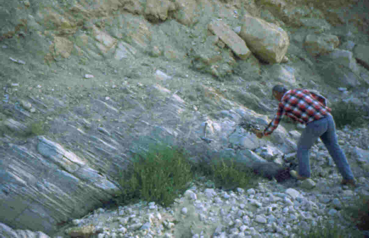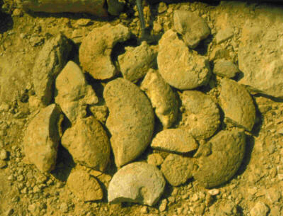Control parameters on the build up of carbonate platforms prior and after the Cenomanian/Turonian boundary in Central Jodan
Frauke Schulze, Jochen Kuss
DFG Ku 642/16
The Cretaceous sediments of Jordan accumulated on a shallow carbonate
platform on the passive continental margin of the African-Arabian plate.
The sedimentation was influenced by the Tethys ocean, by eustatic and
tectonic movements of the Arabo-Nubian shield and the input from the hinterland.
Within the scope of this project, the sedimentary succession of the Ajlun-Group
(Upper Albian to Middle Coniacian, here Turonian) in West Central Jordan
has been investigated in detail. The five formations of the Ajlun-Group
(Naur, Fuheis, Hummar, Shuayb and Wadi As Sir) are mainly built up by
shallow-marine calcareous sediments. The lithostratigraphy, facies and
thickness vary within the working area owing to the main transgressions
of the Tethys ocean from the north to the south and owing to the position
on the shelf platform.
There are three topics, the present work focusses on:
The first is the biostratigraphy of the investigated successions, based on micropalaeontological and macropalaeontological analyses. The most indicativ fossil groups are the ammonites and the planktic foraminifers. Benthic foraminifers, ostracods, rudists, and bivalves are more helpful for the reconstruction of the microfacies and environmental changes. The calcearous nannofossils are to serve as another biostratigraphic tool during the following investigations.
Within the carbonatic/ dolomitic successions of the Naur and the Hummar
Formation high-frequency cyclic stacking patterns can be observed. Their
further investigation will hopefully help us to answer some questions:
Can these cycles be correlated within Jordan? Can we use them to reconstruct
the regional environmental conditions for the particular times? Is it
possible to integrate them into the sequence patterns of the adjacent
areas and the global low-order sequences?
Detailed lithostratigraphic and biostratigraphic as well as geochemic investigations of the Shuayb Formation are the key to a more exact definition of the Cenomanian/Turonian-boundary and enable us to understand the development of the Upper Cretaceous platform during the main transgression. The more calcareous or marly sediments of the boundary interval in the north of the working area contrast with clayey marls or local bituminous shales in the central and southern part.
These sediments seem to be correlatable with the global anoxy-event CTOAE2.
The sedimentary differences give us an idea of the paleorelief of the
Upper Cretaceous platform, the water depth and the faunal changes as well.


